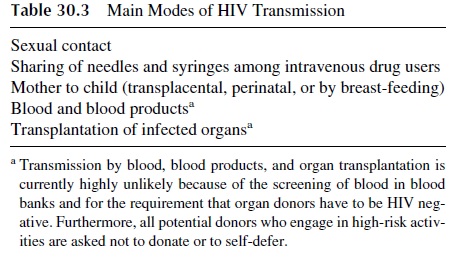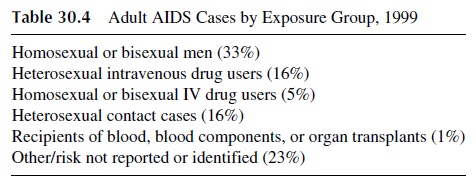Chapter: Medical Immunology: AIDS and Other Acquired Immunodeficiency Diseases
Epidemiology of HIV/AIDS
Epidemiology of HIV/AIDS
By the end of 1999 it was estimated that 34.3 million people had been infected with HIV worldwide, 5.8 million during 1998 alone. Of those new cases, 4 million occurred in austral Africa and 1.2 million cases in South and Southeast Asia, the two hot foci of the epi-demic at this time. During the same period, 21,419 new cases of HIV infection occurred in the United States and Puerto Rico. By the end of 1999, the cumulative figure for AIDS cases in the United States exceeded 730,000, of which about 60% had died. In the United States, the total number of HIV-infected individuals, including those who have and have not yet developed AIDS, is estimated to exceed 370,000.

The main modes of transmission of HIV in the United States are summarized in Table 30.3, and the distribution of adult AIDS cases by exposure group is summarized in Table 30.4. In the United States, the type of sexual contact with the greatest risk is male to male, followed by male to female and female to male. Heterosexual transmission is considerably more common in third world countries but is on the rise in the United States. Factors asso-ciated with increased risk of venereal transmission include receptive anal intercourse, IV drug-using partner, presence of genital ulcers, and multiple partners.

Vertical transmission is a major problem in underdeveloped countries where an-tiretrovirals are not generally available. The infection is most frequently acquired intra-partum (about two thirds of cases). Intrauterine transmission is next in frequency. It usually takes place late in pregnancy, and the infection is acquired either transplacentally or as a
The risk of transplacental or perinatal transmission is directly related to the magnitude of the viral load. Transmission by breast-feeding is estimated to range between 5 and 12% of babies nursing from HIV-positive mothers, and the risk is directly related to the viral load and the duration of breast-feeding. As a general rule, HIV-infected women are advised to avoid breast-feeding.
Related Topics